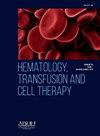A CASE OF FAMILIAL PORFIRIA
IF 1.6
Q3 HEMATOLOGY
引用次数: 0
Abstract
Introduction
Porphyria is a group of metabolic diseases caused by hereditary defects in the enzymatic system of heme biosynthesis. We present three cases of familial porphyria in two sisters (50 and 45-years-old) and a brother (39-years-old). The clinical symptoms of these patients were analyzed, and it was found that all patients have the same symptoms of the disease since childhood: constantly dark urine, burn-like changes on the skin of the face and ears, long-lasting wounds, moderate splenomegaly, and deformity of the joints on the fingers.
Clinical case
Here, we present the some clinical and laboratory data one of the three patients. This patient was initially diagnosed with scleroderma, but due to the splenomegaly, she was referred to a hematologist to clarify the diagnosis. It was found that since childhood she had black urine, poorly healing wounds, and burn-like changes on the face and on the hands, which most often appeared after exposure to the sun. A physical examination revealed splenomegaly (+2‒3 cm). The urine was initially intensely yellow-colored ‒ when exposed to bright sunlight, the color changed to a dark yellow color. Total porphyrins in daily urine were 1.93 mg/L (norm 0‒0.15 mg/L), uroporphyrinogen in single probe urine is 13 mg/L (norm 0‒2 mg/L), and δ-aminolevulinic acid is 16.7 mg/L (norm 0.1‒4.5 mg/L). The patient’s sister and brother also were examined for quantitative tests for porphyrins in the urine. Both had similar porphyrin samples in their urine: total porphyrins in single probe urine – 1.23‒1.3 mg/L, uroporphyrinogen in single probe urine – 12‒13 mg/L, δ-aminolevulinic acid – 17.1 mg/L.
Conclusions
Increased excretion of porphyrin precursors is one of the permanent signs of the disease and is observed not only during acute manifestations of the disease but also during the period of remissions, among the people with the latent form of the disease. Analyzing the results of our discussions, we can draw the following conclusions. Porphyria is a rare disease with very variable clinical symptoms, which causes certain difficulties in its timely diagnosis. To verify the diagnosis, even in the presence of a characteristic clinical picture, it is necessary to study the excretory profile of porphyrin metabolism with quantification of porphyrin precursors and fractions, as well as a comprehensive genetic examination.
家族性porporia 1例
卟啉症是由血红素生物合成酶系统的遗传缺陷引起的一组代谢性疾病。我们报告三例家族性卟啉症的两个姐妹(50岁和45岁)和一个兄弟(39岁)。分析这些患者的临床症状,发现所有患者从小都有相同的疾病症状:尿不断变黑,面部和耳朵皮肤灼烧样改变,伤口持久,中度脾肿大,手指关节畸形。在这里,我们提出一些临床和实验室资料的三个病人之一。该患者最初被诊断为硬皮病,但由于脾肿大,她被转介给血液学家以澄清诊断。发现她从小小便发黑,伤口愈合不良,脸上和手上有烧伤样的变化,这些变化通常是在暴晒后出现的。体格检查显示脾肿大(+ 2-3 cm)。尿液最初呈强烈的黄色,当暴露在明亮的阳光下时,颜色就变成了暗黄色。日尿中总卟啉为1.93 mg/L(正常值0 ~ 0.15 mg/L),单探针尿中尿卟啉原为13 mg/L(正常值0 ~ 2 mg/L), δ-氨基乙酰丙酸为16.7 mg/L(正常值0.1 ~ 4.5 mg/L)。病人的妹妹和弟弟也接受了尿液卟啉定量检测。两者尿液中卟啉含量相近,单探针尿液中总卟啉含量为1.23 ~ 1.3 mg/L,尿卟啉原含量为12 ~ 13 mg/L, δ-氨基乙酰丙酸含量为17.1 mg/L。结论卟啉前体排泄增加是该病的永久性体征之一,不仅在该病的急性表现中,而且在该病的潜伏型患者中,在缓解期也可以观察到卟啉前体排泄增加。分析我们讨论的结果,我们可以得出以下结论。卟啉症是一种罕见的疾病,临床症状多变,给其及时诊断带来一定的困难。为了验证诊断,即使在有特征性临床表现的情况下,也有必要研究卟啉代谢的排泄谱,定量分析卟啉前体和组分,以及全面的遗传检查。
本文章由计算机程序翻译,如有差异,请以英文原文为准。
求助全文
约1分钟内获得全文
求助全文
来源期刊

Hematology, Transfusion and Cell Therapy
Multiple-
CiteScore
2.40
自引率
4.80%
发文量
1419
审稿时长
30 weeks
 求助内容:
求助内容: 应助结果提醒方式:
应助结果提醒方式:


